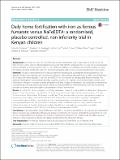| dc.contributor.author | Emily M Teshome, Pauline EA Andang’o, Victor Osoti, Sofie R Terwel, Walter Otieno, Ayşe Y Demir, Andrew M Prentice, Hans Verhoef | |
| dc.date.accessioned | 2020-08-14T07:47:22Z | |
| dc.date.available | 2020-08-14T07:47:22Z | |
| dc.date.issued | 2017-12-01 | |
| dc.identifier.uri | https://repository.maseno.ac.ke/handle/123456789/2113 | |
| dc.description.abstract | Background
We aimed to show the non-inferiority of home fortification with a daily dose of 3 mg iron in the form of iron as ferric sodium ethylenediaminetetraacetate (NaFeEDTA) compared with 12.5 mg iron as encapsulated ferrous fumarate in Kenyan children aged 12–36 months. In addition, we updated a recent meta-analysis to assess the efficacy of home fortification with iron-containing powders, with a view to examining diversity in trial results.
Methods
We gave chemoprevention by dihydroartemisinin-piperaquine, albendazole and praziquantel to 338 afebrile children with haemoglobin concentration ≥70 g/L. We randomly allocated them to daily home fortification for 30 days with either placebo, 3 mg iron as NaFeEDTA or 12.5 mg iron as encapsulated ferrous fumarate. We assessed haemoglobin concentration (primary outcome), plasma iron … | en_US |
| dc.publisher | BioMed Central | en_US |
| dc.subject | Anaemia, Child, Pre-school, Ferric sodium EDTA, Home fortification, Iron, Non-inferiority, Meta-analysis | en_US |
| dc.title | Daily home fortification with iron as ferrous fumarate versus NaFeEDTA: a randomised, placebo-controlled, non-inferiority trial in Kenyan children | en_US |
| dc.type | Article | en_US |

